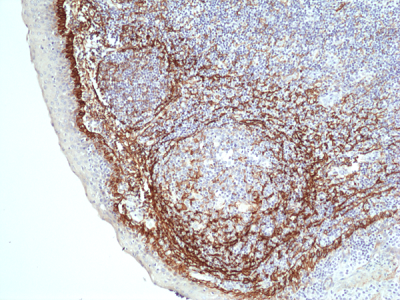anti-Podoplanin (mouse), mAb (RTD4E10)
AG-20T-0101
ApplicationsImmunoPrecipitation, Western Blot, ELISA, ImmunoHistoChemistry
Product group Antibodies
Overview
- SupplierAdipoGen Life Sciences
- Product Nameanti-Podoplanin (mouse), mAb (RTD4E10)
- Delivery Days Customer10
- ApplicationsImmunoPrecipitation, Western Blot, ELISA, ImmunoHistoChemistry
- CertificationResearch Use Only
- ClonalityMonoclonal
- Clone IDRTD4E10
- HostHamster
- IsotypeIgG
- Scientific DescriptionMonoclonal Antibody. Recognizes mouse podoplanin. Does not cross-react with human podoplanin. Isotype: Hamster IgG. Clone: RTD4E10. Applications: ELISA, IHC, IP, WB. Lyophilized. Podoplanin is expressed on glomerular epithelial cells (podocytes), type I lung alveolar cells, lymphatic endothelial cells and numerous tumors, including colorectal tumors, squamous cell carcinomas, testicular seminoma and brain tumors. Podoplanin is the ligand for C-type lectin-like receptor 2 (CLEC-2). Their association is dependent on sialic acid on O-glycans of podoplanin. Through its association with CLEC-2, podoplanin induces platelet aggregation and tumor metastasis. Podoplanin is also necessary for lymphatic vessel formation, normal lung cell proliferation and alveolus formation at birth. - Podoplanin is expressed on glomerular epithelial cells (podocytes), type I lung alveolar cells, lymphatic endothelial cells and numerous tumors, including colorectal tumors, squamous cell carcinomas, testicular seminoma and brain tumors. Podoplanin is the ligand for C-type lectin-like receptor 2 (CLEC-2). Their association is dependent on sialic acid on O-glycans of podoplanin. Through its association with CLEC-2, podoplanin induces platelet aggregation and tumor metastasis. Podoplanin is also necessary for lymphatic vessel formation, normal lung cell proliferation and alveolus formation at birth.
- Storage Instruction-20°C,2°C to 8°C
- UNSPSC12352203

